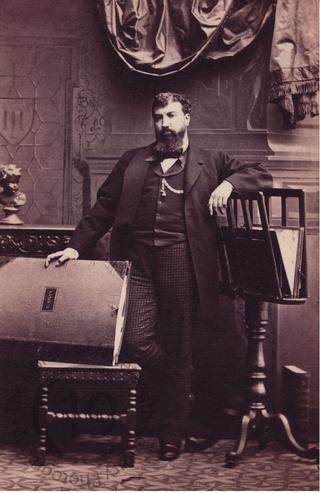
Camille Silvy
A carte-de-visite portrait of Camille Silvy (1834-1910).
Born at Nogent-le-Rotrou (Eure-et-Loire) on 18 May 1834, Camille Silvy came from a distinguished French family of Italian ancestry. He learnt photography from Count Olympe Aguado and exhibited some landscapes as an amateur at Edinburgh and Paris before opening a studio in London towards the end of 1859 or at the very beginning of 1860. The possibility that he was the first photographer in London to work in the new carte-de-visite format is often put forward, but this honour more probably lies with Messrs. Day of Piccadilly.
To gain publicity when the studio first opened, Silvy produced, in the first few months of 1860, a series of portraits of theatrical and operatic stars. He quickly attracted a clientele drawn from the upper echelons of society, although the daybooks show that there was a downward shift in the social standing of his clientele later in the decade. At the height of ‘Cartomania’ in the summer of 1861, he was personally conducting as many as forty sittings a day, but the following year he began the habit of leaving the studio in the hands of others during the winter months, at first in those of his partner, Auguste Renoult, and then, after the partnership was dissolved in May 1864, in those of other members of his staff. By 1868 the popularity of the carte format had significantly declined, and Silvy closed the studio, marking the occasion with a Grande Après-midi Photographique et Musicale held on 17 July 1868 in aid of the French Hospital, Leicester Square. His negatives were acquired by Adolphe Beau, and the contents of the studio, including Silvy's camera equipment and the luxurious properties that had decorated his sets, were auctioned by Messrs. Bonham on 16 December 1872.
Silvy accepted a minor consular post in Exeter, possibly in the hope that it might lead on to a career as a diplomat, but at the outbreak of the Franco-Prussian War he returned to France. His health destroyed – in his opinion, by the chemicals he had handled in the darkroom – he spent nearly the last forty years of his life in a sanatorium. He died there on 2 February 1910 and was buried in Père Lachaise cemetery in Paris.
Throughout the time that he was in London, Silvy kept daybooks in which he, or members of his staff, recorded the day-to-day activity of the studio, probably as a device for locating negatives when clients wished to reorder, but possibly also as an aide-memoire for Silvy. These daybooks comprise one unmounted print from each sitting, pasted in under a sitting number, four to a page, with the name of the sitter entered above. From volume two onwards, the date was also recorded daily. There are some seventeen thousand sittings, spread over twelve volumes, but these contain various lacunae, some inexplicable. There were once thirteen volumes, but volume eleven, covering July 1863 to June 1864, is lost. The National Portrait Galley acquired the surviving twelve volumes in 1904.
Self-portrait by the photographer.
Code: 124229




